The Mill
Part two of our visit with Atco Wood Products, Fruitvale British Columbia. The day before we were in “the woods” with their crew, watching how it’s done out there, this time it’s a look at the firm’s high tech mill. Using logs harvested, in a sustainable way, from forests in the region, we watch as they’re transformed into a multitude of products, plywood veneer mainly, but others as well. They use every last scrap and nothing’s wasted. It’s exciting, efficient and environmentally friendly.
Come see…
Logs are brought in from any number of blocks being worked. While they harvest all species, and the area here is a healthy mix, Atco mainly processes Spruce, Douglas Fir and Larch peeler logs. Cedar or other types not needed or surplus to demand, or logs not suitable for the veneer process, say they’re too large (maximum diameter the mill can use is 30 inches) are then sold off or are traded to other mills who can use them. My cedar for your spruce, that kind of thing.
Loaded trucks enter the yard. First thing, they’re weighed on a huge scale. Then it’s off to the unloading area. Using a massive wheel loader with a huge claw, logs are stacked by species and planned use. Most are destined for the Atco mill, others, those being sold or traded, go to short term storage until needed. Once in a while a load is set aside, temporarily, for spot inspection and quality control.
A sprinkler keeps the wood piles from dying out and cracking (a potential disaster), before being processed. Turn around is quick so logs will only sit for a short time, perhaps less than a few days before entering the mill proper. Stockpiles are increased just before spring breakup, when the woods are shut down for a period due to challenging (meaning soft) conditions out in the field.
It only takes a few minutes to empty the truck. It then heads to a specialized gantry which is used to piggyback the trailer back on to it for a return trip into the woods. A quick reweigh and they’re their on the road. It’s takes mere minutes. Total weight inbound, minus truck weight outbound equals the amount of wood delivered. This giant scale, by the way, is incredibly accurate, down to a kilo or so.
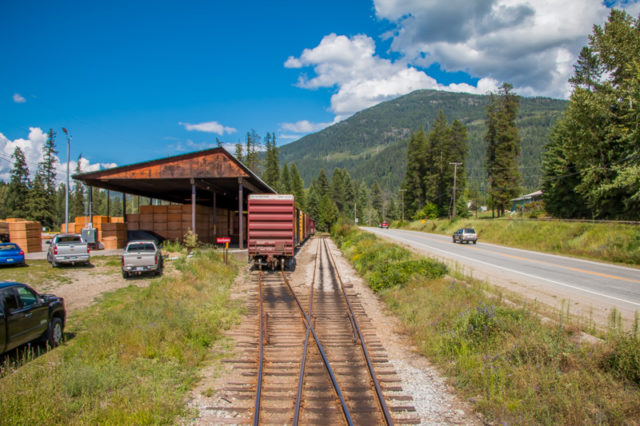
At the Atco Mill Fruitvale, BC – the boxcar loading area.
Logs to be processed, and they run a single species at a time, enter a building and are first debarked, that material, as by-product, being set aside for sale as landscaping mulch or Hog Fuel (stuff that can be burned in specialized boilers). They’re then cut to working length – just over eight feet (wood is still often measured in imperial), so after final trim they’ll equals the length of a sheet of standard plywood. Logs arrive from the field precut in some multiple of that eight foot length so there is little waste in that regard. Every step is well thought out.
The processing happens incredibly fast. The logs just fly! One can help but be awestruck by how it all works. Big machinery, doing this and that with speed and finesse. The little kid inside is pleased. Overseeing every step along the way is a team of experts that watch the action and control the flow, their tech-workstations looking more like the bridge of the Enterprise than anything else.
Moved by another loader, the eight foot logs are next steamed in a giant building, softening them for the peeling step. Multiple batches can be done at one time. How long they’re in the “spa” varies with species or other factors, but it’s not that long. At every step is a quality control process. Rejected logs, those with deep cracks, rotten cores (the lathe can’t grip them), too out of round (won’t peel right) can go to the chipper, or are sometimes set aside for later donation to charities, who then fund-raise by selling them off, after splitting, as fire wood. Again, nothing is wasted. Not a single chip. All steps are highly mechanized. But it still takes a lot of people to keep things flowing efficiently.
Logs are fed into a high speed lathe. In a matter of seconds, no embellishing here, they’re peeled to an exacting thickness, what ever the job requires. Such precision. Now a long thin sheet, moving at a blur, it’s trimmed down to the final eight foot length as it’s sent down a conveyor. At the same time a computer cutter removes both the flawed stuff (knots, decayed wood, insect holes, etc) and under length material on the fly, and then cuts the resultant clean veneer to final width, ideally four feet, but lesser sizes are usable too. Sorting of the non-four foot width pieces is done my hand. It takes finesse. The fellows working this station have to be on the ball.
Scraps and cut-offs found at this step make a quick trip, you guessed it, to the chipper. It’s a hungry beast and needs to be fed!
Sheets are stacked by width and then gets bundled. No kiln or air drying is needed. The material is then sent to the sheet storage area. It won’t be there for long. Most of it travels by railway (Atco’s own little short line, the Nelson and Fort Sheppard) for eventual forwarding to US markets. Every couple/few days a good sized string of boxcars leaves the plant for points south. Some destined for Canada, and odds and ends, moves out by truck.
Meanwhile, the unusable core of the peeled log is set aside, to be made into landscape ties. They first get planed flat on two sides before being bundled and shipped out to customers. I best you know where the rejects go.
Chips are loaded onto specialized trucks, as needed, and taken away. Most heads to a huge plant in the region and becomes pulp, and later newsprint and the like. It’s all used. When they’re done there’s not a single grain of sawdust left behind. One hundred percent of everything brought into the mill is used. Lumber types of old, even a good generation ago, would be blown away!
The whole Atco Mill complex and log storage yard is surprisingly compact. An awful lot is done in a small space! All the plant equipment here is thoroughly modern, and so very efficient. A maintenance crew inspects all machines regularly catching small problems before they become big ones. An on site work shop is kept busy just sharpening saw blades and lathe knives. The latter get ground to an incredible razor-sharpness – heck a razor seems dull compared to these. They get resharpened after a couple hours of use.
A small detached building off to one side houses the offices.
There’s been a mill at this site since the 1940s. In the late 1950s, a descendant of the current owners took over and it’s been a family run operation ever since. Atco’s name is derived from the founder’s first name, Atlee (AT-lee CO-mpany). The firm is not to be confused with the huge Atco Holdings conglomerate based out of Calgary Alberta.

The cutting/debarking station.
The original mill here made dimensional lumber. Later, in the 1970s, they switched over to veneer and haven’t look back (for a time they had a second mill not far away also making dimensional lumber)
Before the steam plant, logs were soaked in a man-made pond prior to processing. This was filed in a long time ago although the creek that fed it still runs behind the plant, as it always has. Back when things weren’t so eco-minded, all scrap materials were burned. The last burner remains on site but is long unused, a reminder of how things were.
The mill directly has some sixty or so people on staff. In addition there’s many, many more contractors, so field crews and truck divers, out in the woods. This makes the firm a major employer in the area. Lots of money goes both directly and indirectly into the local economy because of the Atco firm. The mill is kept busy most days, two shifts or more.
The hills around Fruitvale are well forested and given the company’s commitment to taking care of them they should be at for some time to come.
Fruitvale was founded about a century ago and today is home to some three thousand five hundred people. It’s located in the West Kootenays of BC not terribly north of the US border. The city of Trail is a bit to the west.
There will be one more installment in this series. Rounding out the story, we’ll be documenting the firm’s railway, which takes much of Atco’s products to market. It’s not a long line, but is terribly important to the success of the company. And it has an interesting history. Coming soon.
The people we dealt with while shooting this piece, everyone, was so accommodating, easy to deal with and down right friendly. Who said lumber types are gruff? They made us feel right at home. They struck us as highly dedicated, hard working and acted as though a big happy family. A big thanks to all who tolerated us while we shot this piece.
Part one and three of this series…
The Woods.
The Railway.
More industrial reports…
Turner Valley gave us gas.
A day with the Battle River Railway.
If you wish more information on what you’ve seen here, by all means contact us!
Date: July, 2016.
Location: Fruitvale BC.
Article references and BIG thanks: Scott Weatherford, Atco Wood Products, The rest of the Atco Mill Crew.
A working mill, naturally, is off limits. BIGDoer.com was on location with permission.
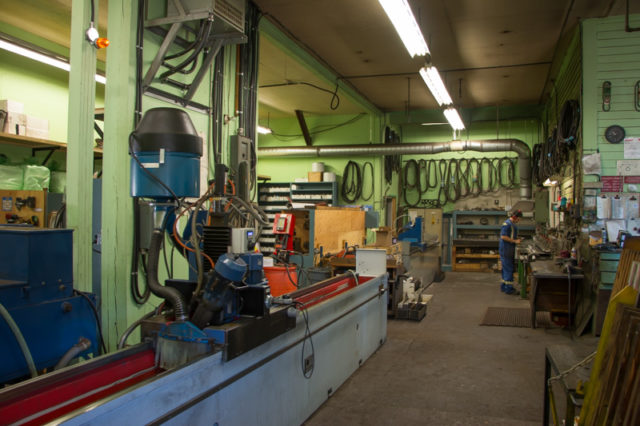
Saw blades and lathe knives are sharpened in this shop.
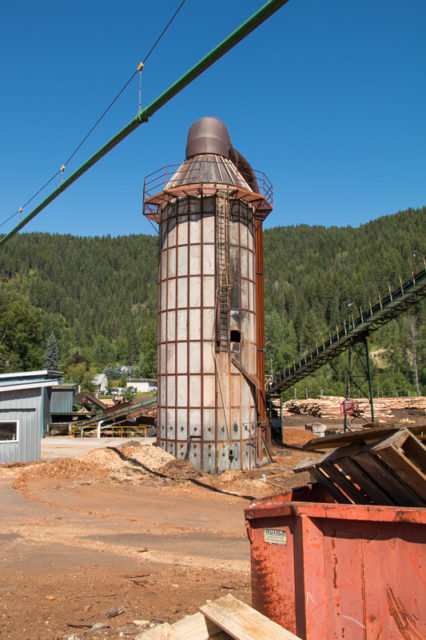
The decommissioned sawdust burner.
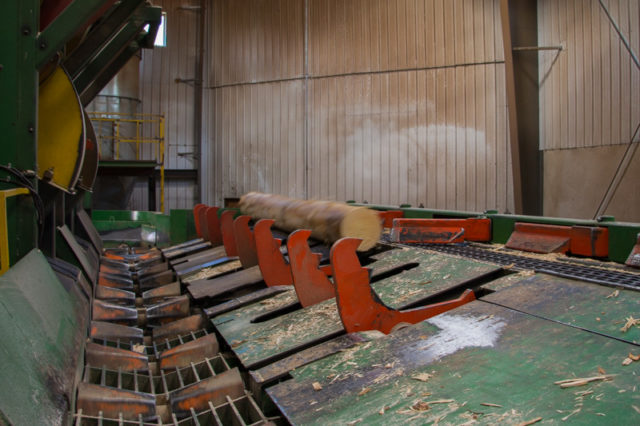
Logs are trimmed to working length (just over 8 feet).
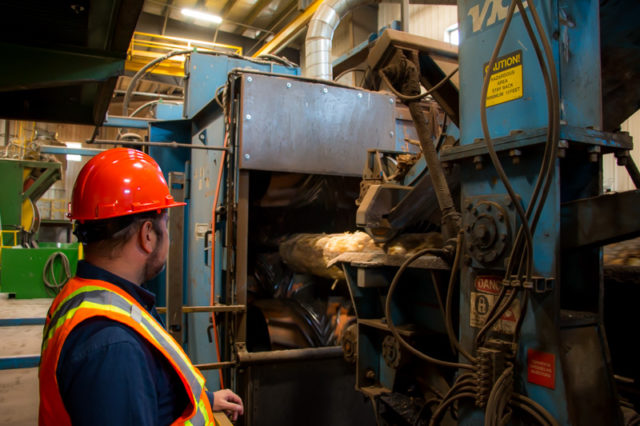
The debarker – our host Scott Weatherford watches the action.
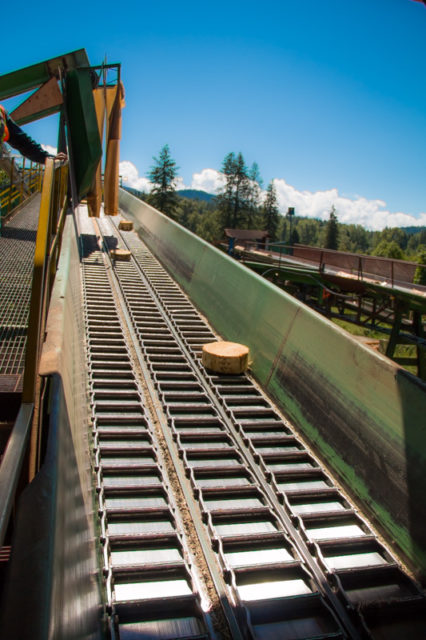
Cut offs destined for the chipper.
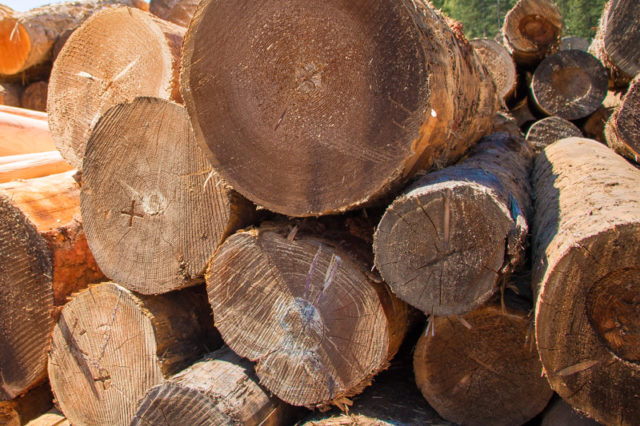
Rejects with cracks, rotten cores and such, set aside for other uses.
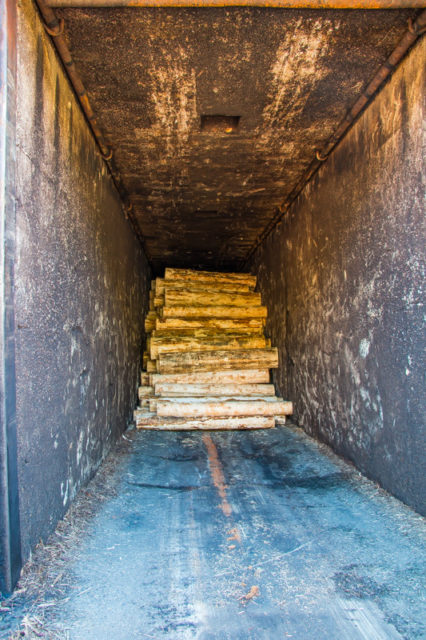
Logs enter the “spa” for a softening.
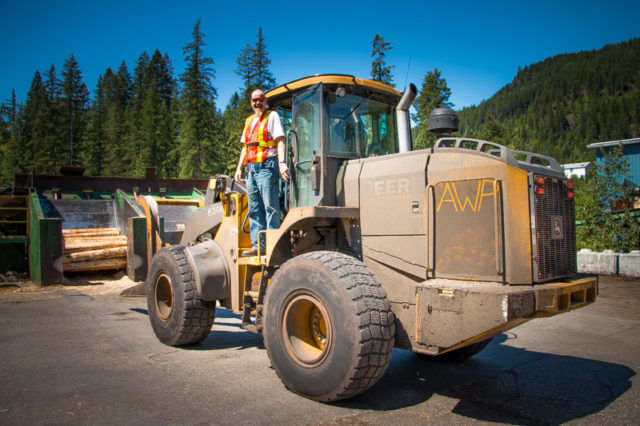
A friendly loader operator. Not all lumber types are gruff.
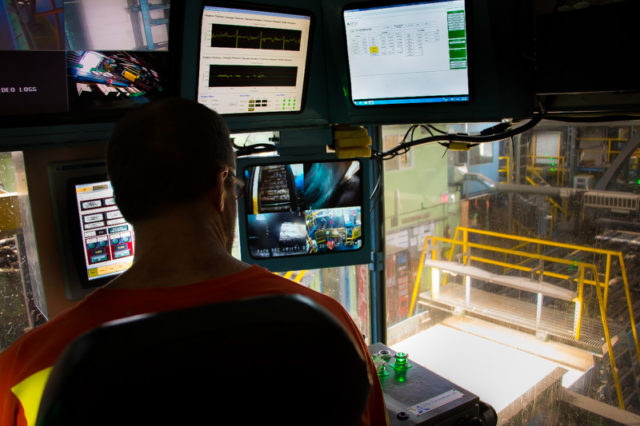
The peeling station.
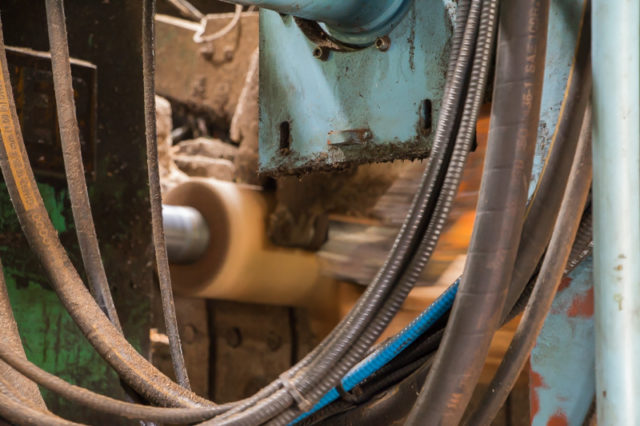
Logs are spun at incredible speed and peeled in mere seconds.
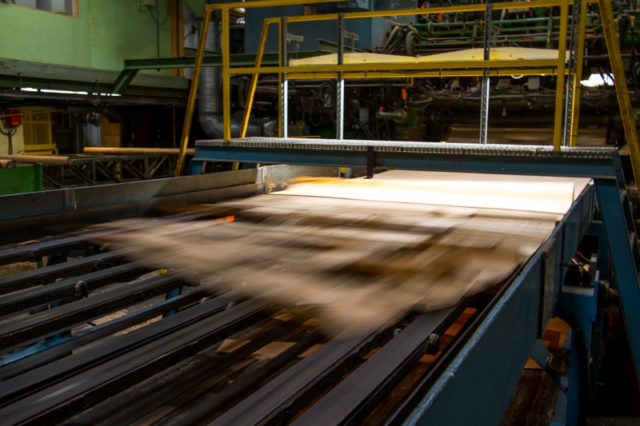
The sheet flies by.
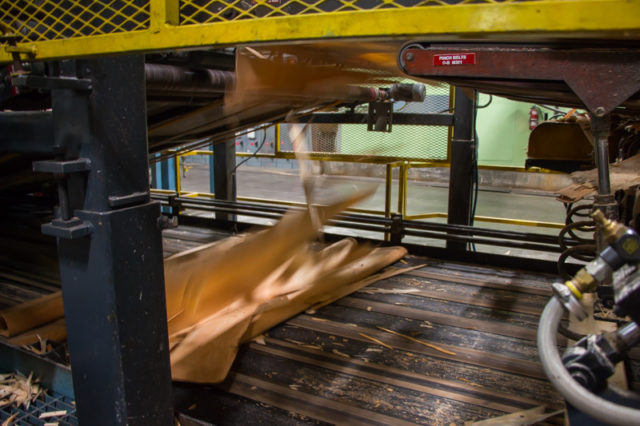
Flawed sections are removed on the fly – it’s a trip to the chipper for them.
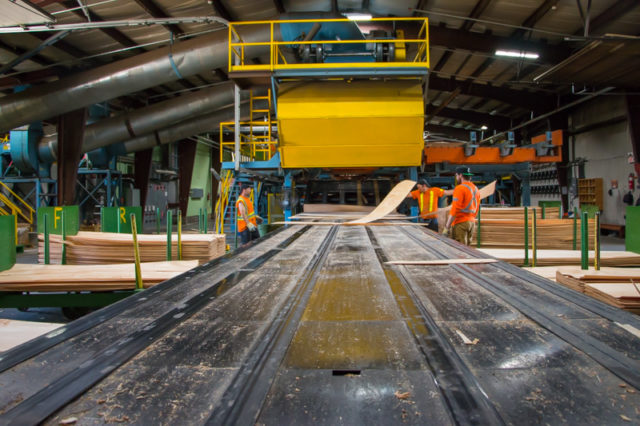
Odd sized sheets are hand sorted here.
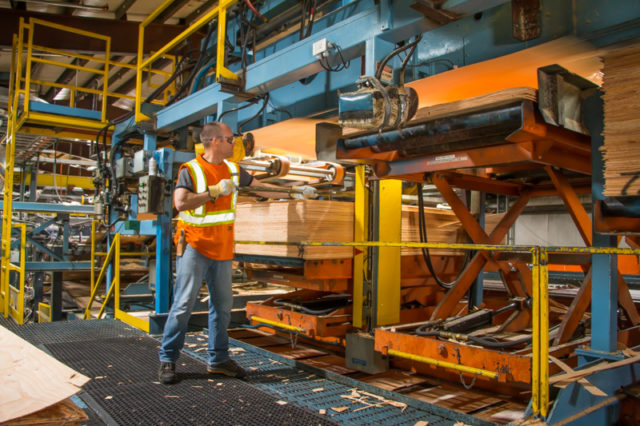
Full four foot wide sheets are stacked here.
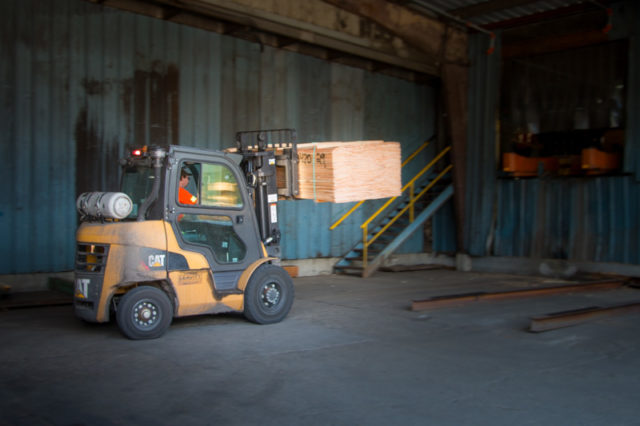
A finished bundle is taken to the loading area.
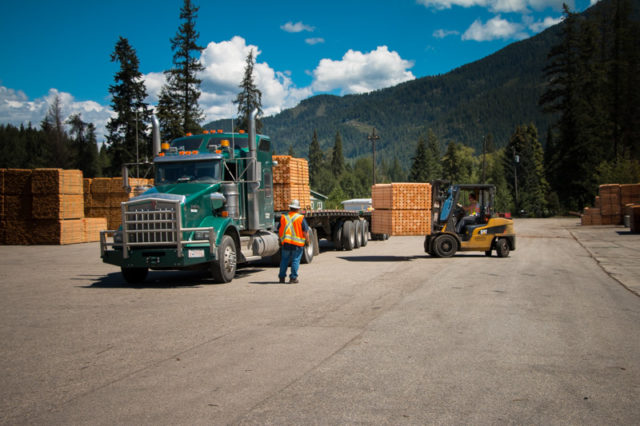
Landscape ties, made from left over cores, get loaded on a truck.
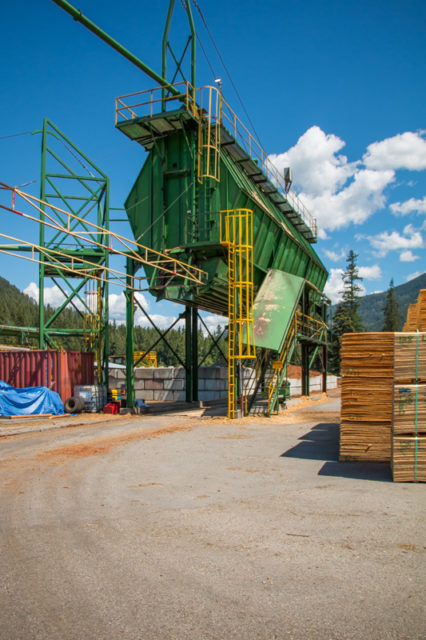
Chip trucks are loaded here.
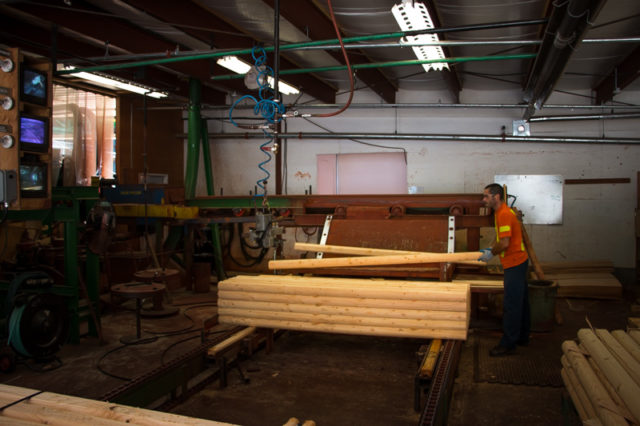
Having just exiting the planer, landscape ties are stacked.
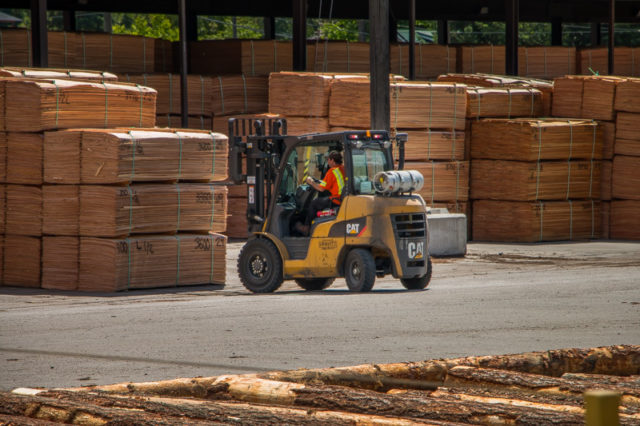
The forklift operators are kept busy.
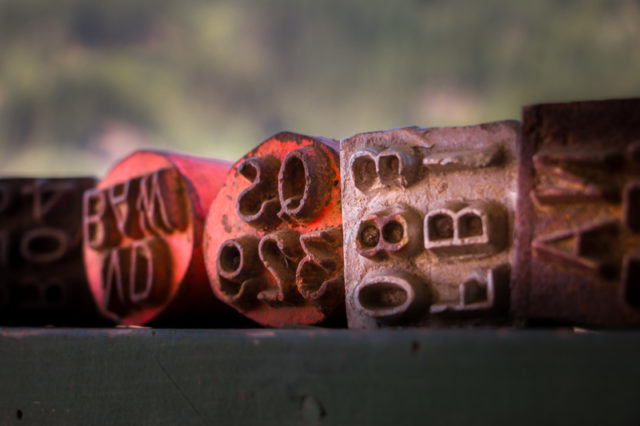
The little details…
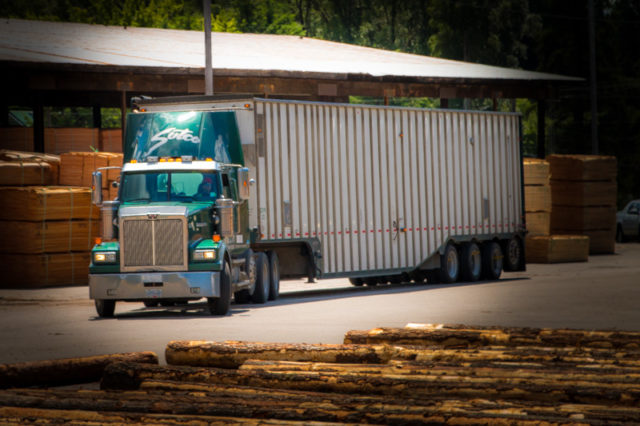
A chip truck arrives for a load.
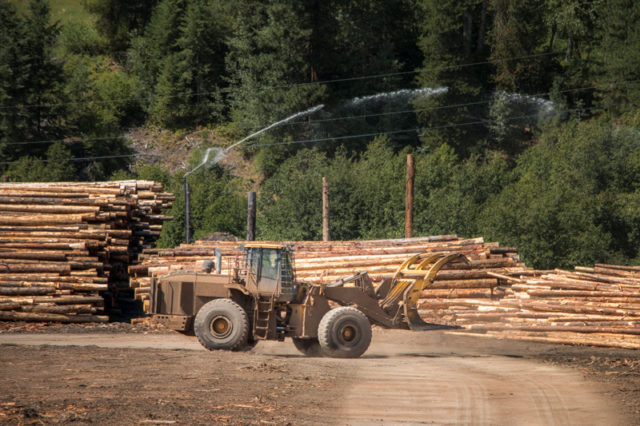
This beast unloads and sorts logs. Sprinkler keeps wood from drying out.
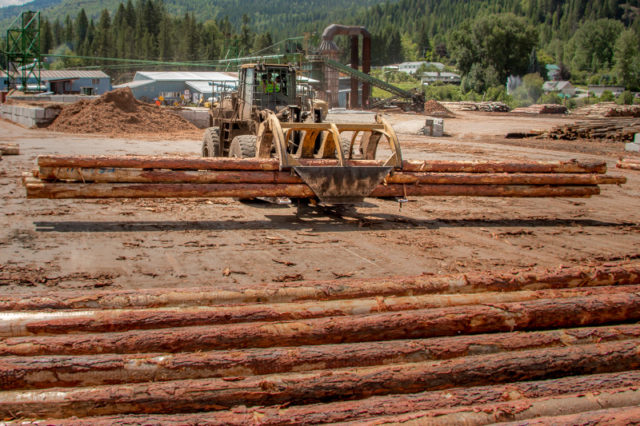
These logs will be spot checked.
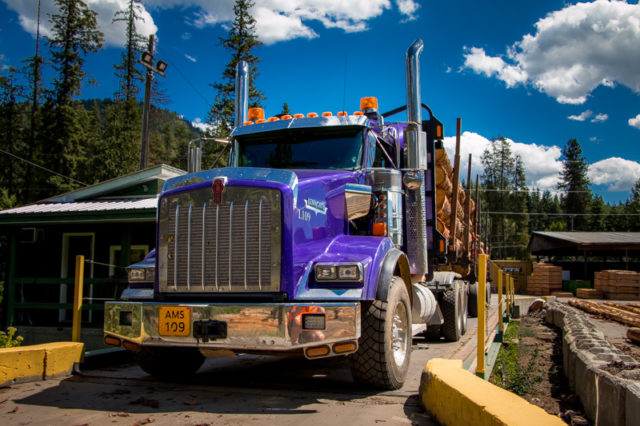
An inbound load is weighed…
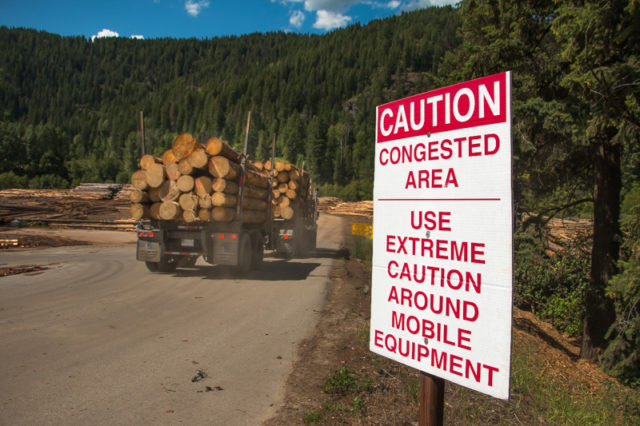
…Then it’s off to be emptied.
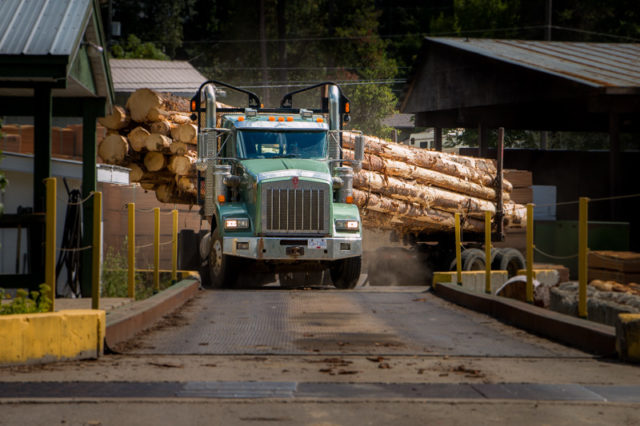
Another load arrives. It’s a busy place.
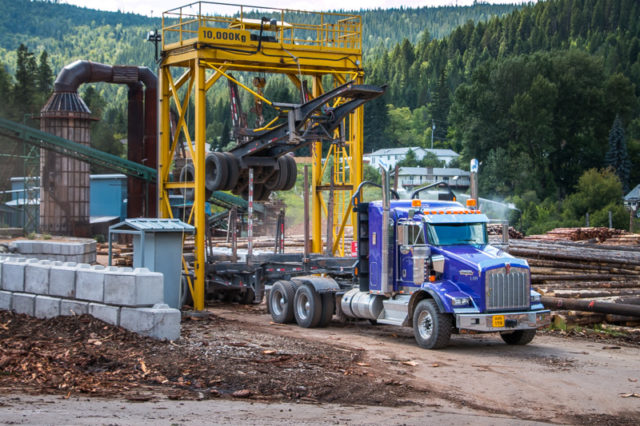
Emptied, the truck’s trailer is piggybacked.
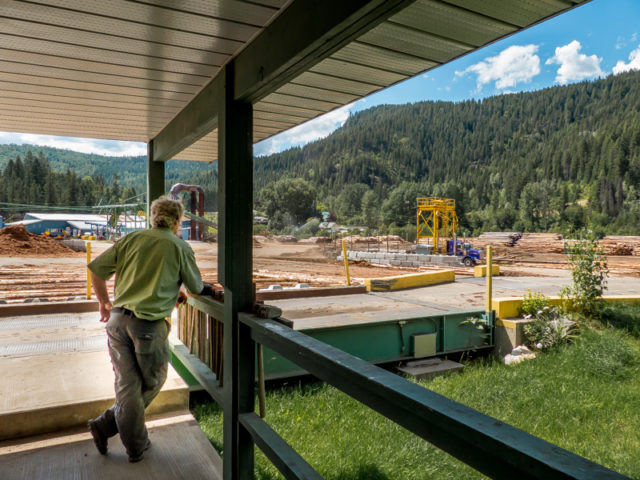
The scale operator in a rare quiet moment.

Finished veneers are mostly moved out by train – US border is just over that hill.

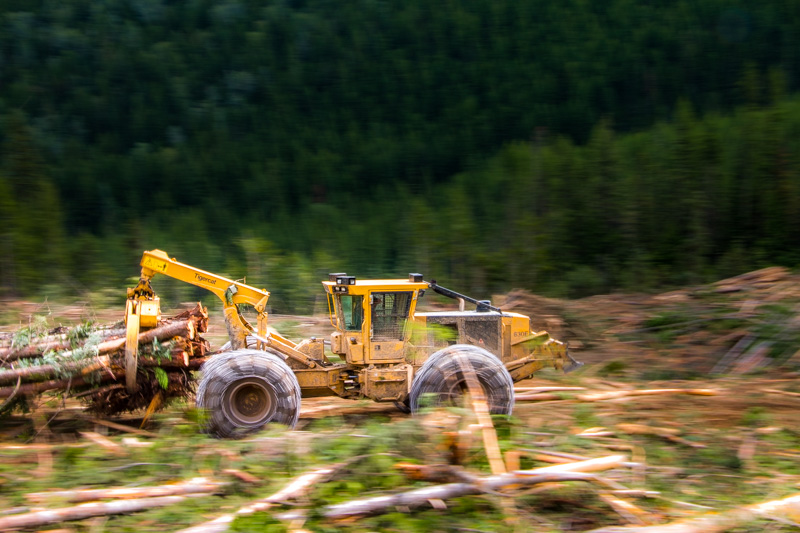

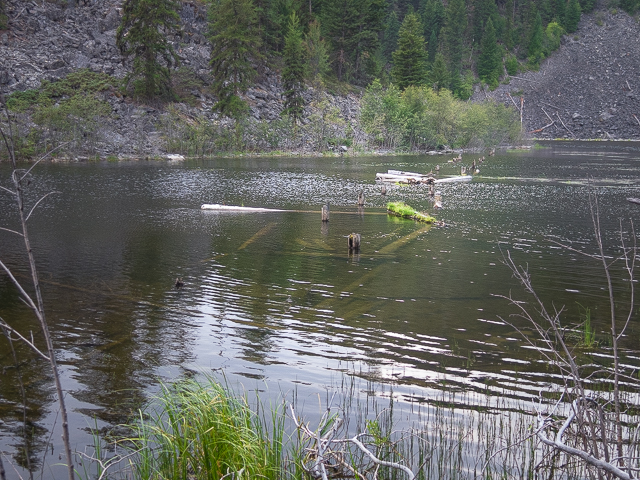


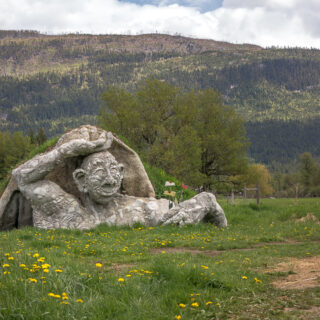

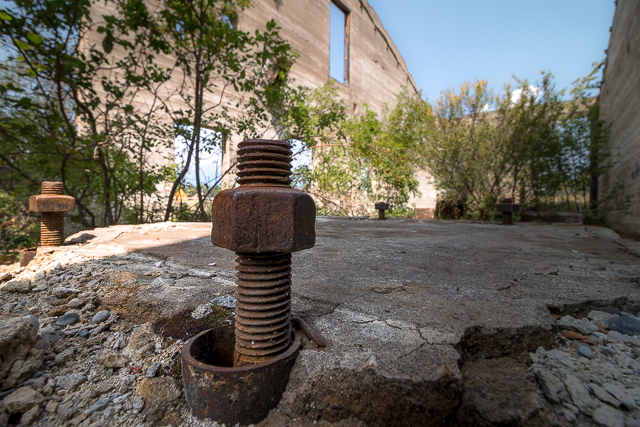
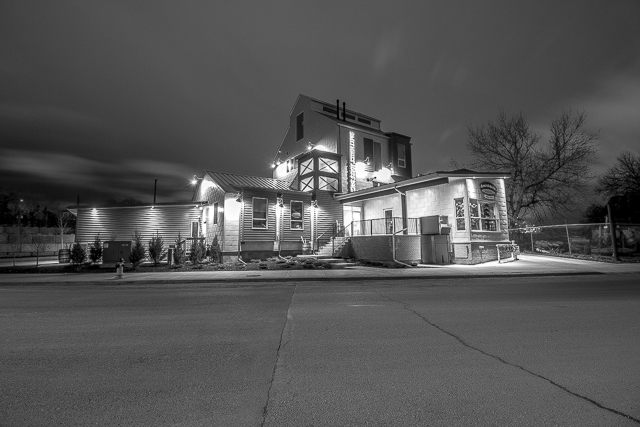
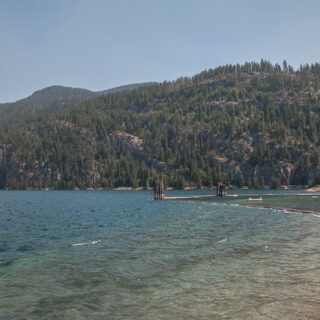
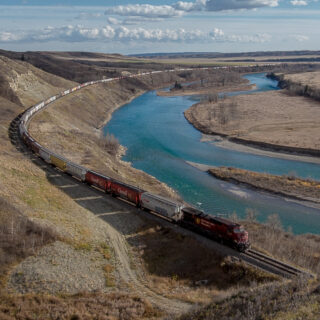
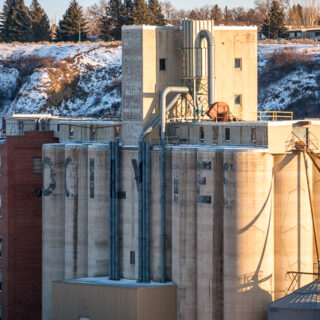
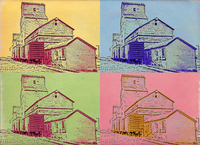





Great article. I went to high school in Trail and spent a lot of time in Fruitvale. When I have been back recently I love to stop and look at the mill. I am thinking of doing a representation of it with my model rr. Thanks for the great yard shots as that is hard to do from the road. It gives me great ideas when these photos are coupled with satellite photos on google. Great work and keep it up.
Thank you! It’d be great to model! It’s nice and compact in size and it’s always busy shipping out product. Perfect! Keep us updated if you follow through with those plans.
Use for the burner, turn it into a big smoker!
Pulled pork, beef ribs, chicken wings, bacon wrapped corn cobs, oh yeah I could see it!
Shame on them cutting up trees for plywood. They should just get them from Rona like the rest of us.
Hahaha! Yeah, it’s crazy they’re doing it the hard way.
This just begs to made into a model for my railway!
I know. It’s so compact, it’d be perfect.
Very nice to see this small business thriving. We lost a mill in Canal Flats recently and it was a big blow to the community. Everyone logs here, or at least they used to.
I know, it must have been scary. The Atco Mill seems to be on a solid footing and should continue to operate of some time to come. Wish them the best.
(via Facebook)
Totally amazing!!
Thanks, I hope you learned something!
Great info Chris, love your articles and pictures! Any chance of doing a dimensional sawmill?
Working on it! Can’t guarantee, but it’s on my wish list.
So good to read a positive story about the forestry biz. It means jobs and is great for our small towns.Years ago so many small towns had a sawmill and when they gradually closed all those small places died, So sad. Good news this one’s doing good! Fantastic write up.
Thanks, it was exciting to see a place that’s doing good business, has a future, cares and has a happy workforce. I wish them continued success.
Another great one! Can’t wait for part 3!
Another week or so! Thanks for commenting.
I hope when I’m 80 I can still be working in the woods. I want to die there.
It’s fantastic when you find some thing you love!